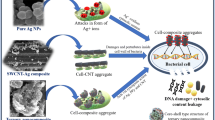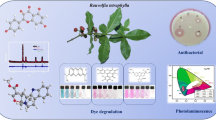Abstract
Water pollution is a real threat to existence of life on earth. Among major water pollutants, hazardous organic dyes present in industrial effluents need to be immediately addressed. These dyes can be photodegraded using nanocatalysts. Metal-based nanocatalysts are preferred for photocatalytic applications due to their high surface area and suitable energy band gap to produce and sustain photo-generated electrons and holes. Therefore, AgNPs of different morphology (cubic and rod shape) has been reported in current study. AgNPs in form of nanocubes and nanorods have been synthesized by polyol reduction method using ethylene glycol as reducing agent and polyvinylpyrrolidone (PVP) as capping agent. Effect of etchants (KCl and FeCl2) was studied on the morphology of AgNPs. The prepared nanocubes and nanorods were characterized by UV-visible, powder X-ray diffraction (PXRD), and scanning electron microscope (SEM). Nanocubes and nanorods were eventually evaluated for their photocatalytic potential under sunlight irradiation. Silver nanorods were found more active for photocatalytic degradation of methylene blue (MB) dye with 88% degradation after 110 minutes. Antibacterial potential of AgNPs was also evaluated by disk diffusion method against gram-positive and gram-negative strains. AgNPs were found more noxious against gram-negative bacterial strains.
Graphical Abstract









Similar content being viewed by others
Data Availability
The datasets generated during and/or analyzed during the current study are available from the corresponding author on reasonable request.
References
Al-Zaban, M. I., Mahmoud, M. A., & AlHarbi, M. A. (2021). Catalytic degradation of methylene blue using silver nanoparticles synthesized by honey. Saudi Journal of Biological Sciences, 28(3), 2007–2013.
Arai, M. S., & de Camargo, A. S. (2021). Exploring the use of upconversion nanoparticles in chemical and biological sensors: from surface modifications to point-of-care devices. Nanoscale Advances, 3(18), 5135–5165.
Cao, X., Zhu, L., Bai, Y., Li, F., & Yu, X. (2022). Green one-step synthesis of silver nanoparticles and their biosafety and antibacterial properties. Green Chemistry Letters and Reviews, 15(1), 28–34.
Chen, Y., Wang, P., Hao, H., Hong, J., Li, H., Ji, S., & Han, X. (2021). Thermal atomization of platinum nanoparticles into single atoms: An effective strategy for engineering high-performance nanozymes. Journal of the American Chemical Society, 143(44), 18643–18651.
Ghamarpoor, R., & Jamshidi, M. (2022). Synthesis of vinyl-based silica nanoparticles by sol–gel method and their influences on network microstructure and dynamic mechanical properties of nitrile rubber nanocomposites. Scientific Reports, 12(1), 1–15.
Gherbi, B., Laouini, S. E., Meneceur, S., Bouafia, A., Hemmami, H., Tedjani, M. L., & Menaa, F. (2022). Effect of pH value on the bandgap energy and particles size for biosynthesis of ZnO nanoparticles: Efficiency for photocatalytic adsorption of methyl orange. Sustainability, 14(18), 11300.
Hong, G. B., Luo, Y. H., Chuang, K. J., Cheng, H. Y., Chang, K. C., & Ma, C. M. (2022). Facile synthesis of silver nanoparticles and preparation of conductive ink. Nanomaterials, 12(1), 171.
Ismail, M., Akhtar, K., Khan, M., Kamal, T., Khan, M. A., M Asiri, A., & Khan, S. B. (2019). Pollution, toxicity and carcinogenicity of organic dyes and their catalytic bio-remediation. Current Pharmaceutical Design, 25(34), 3645–3663.
Jabbar, I., Zaman, Y., Althubeiti, K., Al Otaibi, S., Ishaque, M. Z., Rahman, N., & Del Rosso, T. (2022). Diluted magnetic semiconductor properties in TM doped ZnO nanoparticles. RSC Advances, 12(21), 13456–13463.
Khan, I., Saeed, K., Zekker, I., Zhang, B., Hendi, A. H., Ahmad, A., & Shah, L. A. (2022). Review on methylene blue: its properties, uses, toxicity and photodegradation. Water, 14(2), 242.
Khandel, P., Shahi, S. K., Soni, D. K., Yadaw, R. K., & Kanwar, L. (2018). Alpinia calcarata: Potential source for the fabrication of bioactive silver nanoparticles. Nano Convergence, 5(1), 1–17.
Kiio, T. M., & Park, S. (2021). Physical properties of nanoparticles do matter. Journal of Pharmaceutical Investigation, 51(1), 35–51.
Lin, C.-C., Lai, Y.-P., & Wu, K.-Y. (2022). A high-productivity process for mass-producing Fe3O4 nanoparticles by co-precipitation in a rotating packed bed. Powder Technology, 395, 369–376.
Mavaei, M., Chahardoli, A., Shokoohinia, Y., Khoshroo, A., & Fattahi, A. (2020). One-step synthesized silver nanoparticles using isoimperatorin: Evaluation of photocatalytic, and electrochemical activities. Scientific Reports, 10(1), 1–12.
Meikle, T. G., Dyett, B. P., Strachan, J. B., White, J., Drummond, C. J., & Conn, C. E. (2020). Preparation, characterization, and antimicrobial activity of cubosome encapsulated metal nanocrystals. ACS Applied Materials & Interfaces, 12(6), 6944–6954.
Monti, E., Ventimiglia, A., Garcia Soto, C. A., Martelli, F., Rodríguez-Aguado, E., Cecilia, J. A., & Albonetti, S. (2022). Effect of the colloidal preparation method for supported preformed colloidal Au nanoparticles for the liquid phase oxidation of 1, 6-hexanediol to adipic acid. Catalysts, 12(2), 196.
Olga, M., Jana, M., Anna, M., Irena, K., Jan, M., & Alena, Č. (2022). Antimicrobial properties and applications of metal nanoparticles biosynthesized by green methods. Biotechnology Advances, 58, 107905.
Safo, I., Werheid, M., Dosche, C., & Oezaslan, M. (2019). The role of polyvinylpyrrolidone (PVP) as a capping and structure-directing agent in the formation of Pt nanocubes. Nanoscale Advances, 1(8), 3095–3106.
Schmidt, R., Prado-Gonjal, J., & Morán, E. (2022). Microwave assisted hydrothermal synthesis of nanoparticles. arXiv preprint arXiv:2203.02394
Shnoudeh, A. J., Hamad, I., Abdo, R. W., Qadumii, L., Jaber, A. Y., Surchi, H. S., & Alkelany, S. Z. (2019). Synthesis, characterization, and applications of metal nanoparticles Biomaterials and bionanotechnology (pp. 527–612). Elsevier.
Siddiqi, K. S., Husen, A., & Rao, R. A. (2018). A review on biosynthesis of silver nanoparticles and their biocidal properties. Journal of nanobiotechnology, 16(1), 1–28.
Siddique, A. B., Ahmad, S., Shaheen, M. A., Ali, A., Tahir, M. N., Vieira, L. C., & Siddeeg, S. M. (2022). Synthesis, antimicrobial potential and computational studies of crystalline 4-bromo-2-(1,4,5-triphenyl-1H-imidazole-2-yl) phenol and its metal complexes. CrystEngComm, 24, 8237.
Tawade, B. V., Apata, I. E., Singh, M., Das, P., Pradhan, N., Al-Enizi, A. M., & Raghavan, D. (2021). Recent developments in the synthesis of chemically modified nanomaterials for use in dielectric and electronics applications. Nanotechnology, 32(14), 142004.
Van Swieten, T. P., Van Omme, T., Van Den Heuvel, D. J., Vonk, S. J., Spruit, R. G., Meirer, F., & Rabouw, F. T. (2021). Mapping elevated temperatures with a micrometer resolution using the luminescence of chemically stable upconversion nanoparticles. ACS applied nano materials, 4(4), 4208–4215.
Vasiljevic, Z., Dojcinovic, M., Vujancevic, J., Jankovic-Castvan, I., Ognjanovic, M., Tadic, N., & Nikolic, M. (2020). Photocatalytic degradation of methylene blue under natural sunlight using iron titanate nanoparticles prepared by a modified sol–gel method. Royal Society Open Science, 7(9), 200708.
Wang, R., Yang, R., Wang, B., & Gao, W. (2016). Efficient degradation of methylene blue by the nano TiO2-functionalized graphene oxide nanocomposite photocatalyst for wastewater treatment. Water, Air, & Soil Pollution, 227(1), 1–9.
Wang, Y., Wang, Y., Bai, J., Duan, S., Wang, R., & Lau, W.-M. (2022). In-situ etching synthesis of 3D self-supported serrated Ni-WO3 for oxygen evolution reaction. Journal of Alloys and Compounds, 893, 162134.
Zaman, Y., Ishaque, M. Z., Ajmal, S., Shahzad, M., Siddique, A. B., Hameed, M. U., & Yasin, G. (2023). Tamed synthesis of AgNPs for photodegradation and anti-bacterial activity: Effect of size and morphology. Inorganic Chemistry Communications, 150, 110523.
Zamana, Y., Ishaquea, M., Sattarb, R., Rehmanb, M., Sabac, I., Kanwala, S., & Qadirb, R. (2022). Antibacterial potential of silver nanoparticles synthesized using tri-sodium citrate via controlled exploitation of temperature. Digest Journal of Nanomaterials and Biostructures, 17(3), 979–987.
Zhang, M., Liu, M., Jiang, Y., Li, J., & Chen, Q. (2020). Synthesis of immobilized CdS/TiO2 nanofiber heterostructure photocatalyst for efficient degradation of toluene. Water, Air, & Soil Pollution, 231(3), 1–11.
Acknowledgements
This work was financially supported by Higher Education Commission Start up research grant Program No: 21-2079/SRGP/R&D/HEC/2018.
Author information
Authors and Affiliations
Corresponding authors
Ethics declarations
Conflict of Interest
The authors declare no competing interests.
Additional information
Publisher’s Note
Springer Nature remains neutral with regard to jurisdictional claims in published maps and institutional affiliations.
Rights and permissions
Springer Nature or its licensor (e.g. a society or other partner) holds exclusive rights to this article under a publishing agreement with the author(s) or other rightsholder(s); author self-archiving of the accepted manuscript version of this article is solely governed by the terms of such publishing agreement and applicable law.
About this article
Cite this article
Ishaque, M.Z., Zaman, Y., Shahzad, M. et al. Photocatalytic and Antibacterial Potential of Silver Nanocubes and Nanorods Synthesized via Polyol Reduction Method. Water Air Soil Pollut 234, 252 (2023). https://doi.org/10.1007/s11270-023-06269-w
Received:
Accepted:
Published:
DOI: https://doi.org/10.1007/s11270-023-06269-w




